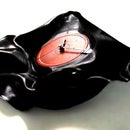Introduction: Rainbow Roller
A roller that paints rainbows!!!
Kids love painting instant rainbow and if you're a supporter of LGBT rights, show your appreciation by coloring this drab world with the pride rainbow. Instead of painting a single color, the rainbow roller blends 10 colors placed in the VIBGYOR order into a beautifully blended rainbow to help make everything a part of fantasy-land themed world.
Now to find that unicorn...
Note: Contrary to what might seem apparent in the images, using the roller on a vertical wall has a good enough angle to keep the paint from spilling. Watch the video to get an idea of usage on vertical surfaces.
Step 1: Go Get Stuff!
- Acrylic sheet 3mm or more.
- Non-absorbant sponge. Something that isn't too absorptive will do. I used the ones used in beddings and cushions.
- Super absorptive kitchen cleaning sponge.
- A 160mm x 35mm paint roller.
- Acrylic paint set. Should have atleast 10 colors in rainbow sequence.
- Super glue.
- Hand file
Step 2: Slicing Acrylic
I had a large sheet of 2mm acrylic lying about. I decided to use it for this project but I later came to realize that gluing 2mm acrylic at 90 degrees is a royal pain. That's why you'll notice streaks of dried super glue all around the acrylic box I made. So go with 3mm acrylic if you have the option.
I always cut my own acrylic but since there were so many pieces, I decided to use the help of a local shop with access to a table saw. The measurements of pieces required followed by quantity:
- 17cm x 4.5cm - x2
- 2cm x 4.5cm -x11
- 11cm x 4.5cm -x1
- 7cm x 2.5cm -x1 (this is mistakenly represented by a smaller piece in the image)
Step 3: Making the Color Slot Box
Divide the 2 17cm x 4.5cm pieces lengthwise into 1.6cm segments with a marker. There will be an extra 1cm left at the end which is for spacing. Glue the 11 2cm x 4.5cm pieces vertically at the markings. Finally glue the other side over it to complete the color slot box.
Also glue the 11cmx4.5cm piece at right angle to the box at the side with the 1cm spacing. Look at the finished product images to get an idea of the location at which it is to be glued.
Step 4: Cut and Attach Absorptive Sponge
Cut the absorptive sponge into 16cm x 3cm rectangle. Cut out about 5mm slits into one side every 1.6cm. Insert it into the slot aligning it with the slits you just made. Use super glue to stick it the acrylic permanently. This sponge will transport the paints to the roller.
Step 5: Cut and Shape Non-absorptive Sponge
Mark the length of sponge required. Keep it about a centimeter extra so it should be around 17cm. Keep the width about 3cm and round off one side with cutter or scissors. This rounded edge will be used to keep the absorptive sponge in position so it doesn't bend too much. I had planned on using this sponge to transfer the paint to the roller with direct contact but it turned out to be non-absorptive and friction between roller and this sponge was too much.
Now mark out 9 cuts of about 1cm at equal distance along its length. These will be pushed into the slots of the box and prevent the paint from draining out at once. Keep the absorptive sponge visible from the other side as they need to be in contact with the paint. You will have to squeeze them into the slots and this will keep the paint from draining any other way than through the absorptive sponge.
Step 6: File the Roller Handle
Pick up a file and flatten both sides of the handle just before the 90 degree bend. This will allow the acrylic vice we will be making in the next step to hold on tightly.
Step 7: Roller and Box Meet at Last
Heat bend the 7cm x 2.5cm acylic piece so it takes the shape as shown in the first image. The bend should be slightly smaller than the thichness of handle. Glue it to the bigger acrylic piece.
As shown in the second image, mark where the 90 degree turn comes and file a notch in the acrylic piece we just heat bent. This will ensure the handle doesn't move from side to side.
Now place the handle between the 2 pieces of acrylic which is kind of the primitive vice we've made. Make sure the filed sides of the handle in the previous step makes the handle sit flat against the 2 acrylic pieces it is sandwiched between. Also the 90 degree bend should fit in the notch you've filed.
Now I wanted to drill a hole at the end of the acrylic and press the handle between the 2 pieces but tightening a nut and bolt but I had no drill available so used sellotape which worked out just fine to press them together tightly.
As shown in 2nd and 3rd image, cut off the corner of the acrylic piece so it does not hit the surface when using the roller.
Step 8: Support at the Other Side
Take a metal rod piece of about 10-15cm and bend it into a right angle. I used a short piece cut from a clothes hanger. File the inner side of one arm flat so that when the other arm is inserted into the end of the roller opposite to the handle, the flattened part sits flat on the side of the acrylic box. Apply super glue to the metal rod and acrylic box side to glue them together. This will provide support at the opposite end of the box and keep it from twisting about.
Notice that the absorptive sponge is like a curtain in front by default but as soon as the roller starts being pulled, it gets pulled in. To keep it from bending too much and make good contact with the roller, the curved part of the non-absorptive sponge plays an important role.
Step 9: Using Watercolors: Fail :(
At the first try, I used watercolors which did get absorbed through the sponge into the roller and form a beautiful rainbow on the roller, but when I tried using it on paper, it only left lightly tinted water droplets on the paper. Turns out watercolors need to be applied thick. If you water it down too much, it will not leave a color but thick paint will not be absorbed through the sponge.
So my sister suggested I try acrylic and they look promising. A quick trip to the market and......
Step 10: Fill in Acrylic Paints: Success!
Acrylic paints when wet, can be somewhat mixed with water to dilute them. This lets the absorptive sponge absorb the color and pass it on to the roller. The roller then delivers the color to your canvas and spits forth mighty rainbows! The colors blend together beautifully and provides a great looking rainbow.
You will have to experiment with the amount to water to paint ratio. Usually 2 parts water and 1 part paint worked good. Prepare the paints in separate cups(I used chocolate box plastic cut into tiny cups) and keep them ready. Start pouring them into the slots in order and keep it over a sink or a newspaper as it will drip initially while you are busy pouring. Take a newspaper and start rolling the roller on the same area over and over again till the roller gets uniformly coated with color. Anytime the roller starts getting dry, pour a bit of water into the slot and it will get running again.
Now go convert this dull world into something more colorful: build giant rainbows on your walls, convert the gray pavements into a rainbow path, rainbow colored tree trunks... you get the point.
Step 11: Bonus: Physical Facebook CelebratePride
Use the roller to paint any physical image in the pride colors. It could be your own printed photograph, your neighbor's, the missing pet's pic on the notice, the mayor's on the pamphlet, a celebrity in the newspaper, an ad bill stuck to wall, etc. I've shown an example by printing my own profile picture and coloring it physically.
Hope you liked my instructable!

Grand Prize in the
Rainbow Contest

Participated in the
Before and After Contest











